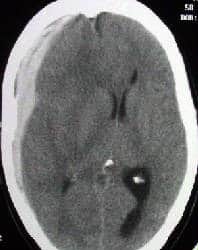 Head injury in the anticoagulated patient can be a challenge. Below is the approach I use. I then read a 2012 paper from the Annals of Emergency Medicine, which gives us the evidence on what our approach might be.
Head injury in the anticoagulated patient can be a challenge. Below is the approach I use. I then read a 2012 paper from the Annals of Emergency Medicine, which gives us the evidence on what our approach might be.
Here’s the scenario. A 56 yo male is brought to the emergency department following a mechanical fall at work. He has hit his head. He hasn’t lost consciousness, his GCS is 15, but has had a significant fall from a standing height. You find that he has a history of cardiac disease and is on clopidogrel. Do you CT scan this patient’s brain? If so, when? Do you admit for observation as he is on a blood thinner.
Here’s a second scenario. A 68 yo woman is brought to the emergency department following a mechanical fall, from a standing height and a head strike. She lost consciousness for 2-3 seconds. On assessing the patient you find that she is on warfarin for atrial fibrillation. Does she need a scan? When? Should be be admitted for observation? Should the warfarin be reversed?
My approach to CT’s is simple. I use my own ‘HAAGLE’ formula(as I used to have to haggle with the radiology registrar to get a head CT). It applies to the lower risk head injury, not the major head injury; they’re straightforward; just scan them all.
Here it is: (Only one of these is needed to trigger a scan)
H– Headache that the physician considers significant
A– Amnesia- ante or retrograde in nature of > 30 minutes
A– Anticoagulated- and this includes warfarin and clopidogrel. I also include aspirin
G– GCS of < 15 at any time
L– Loss of consciousness at any time
E– Emesis of > 2 episodes
In terms of when to scan; I do so when the patient comes in. There is certainly evidence that bleeds can occur later in the elderly, however most will have a bleed when they come in?
A recent article by Nishijima et al Ann Emerg Med 2012;59(6):460-468,can help us. The authors looked at ‘Immediate and delayed traumatic intracranial haemorrhage in patients with head trauma and pre injury warfarin or clopidogrel use’
It was a prospective observational study of 1064 patients. Patients were followed for two weeks after their initial presentation.
Of the total group of 1064 patients , 768 were on warfarin and 296 were on clopidogrel.
Immediate intracranial haemorrhage was present in:
- 12% of those receiving clopidogrel vs 5.1% of those receiving warfarin.
Delayed intracranial haemorrhage ie., within 2 weeks was present in:
- 0% on clopidogrel vs 0.6% of patients on warfarin
This study indicates that a CT on patient arrival to the emergency department is still very reasonable. It also indicates that a very small percentage of patients have a delayed bleed. It is therefore appropriate, unless there are other concerns to discharge these patients, without a repeat head CT, however with strict instructions, because delayed bleeding can occur. There is also no need to reverse anticoagulation if it is therapeutic.




